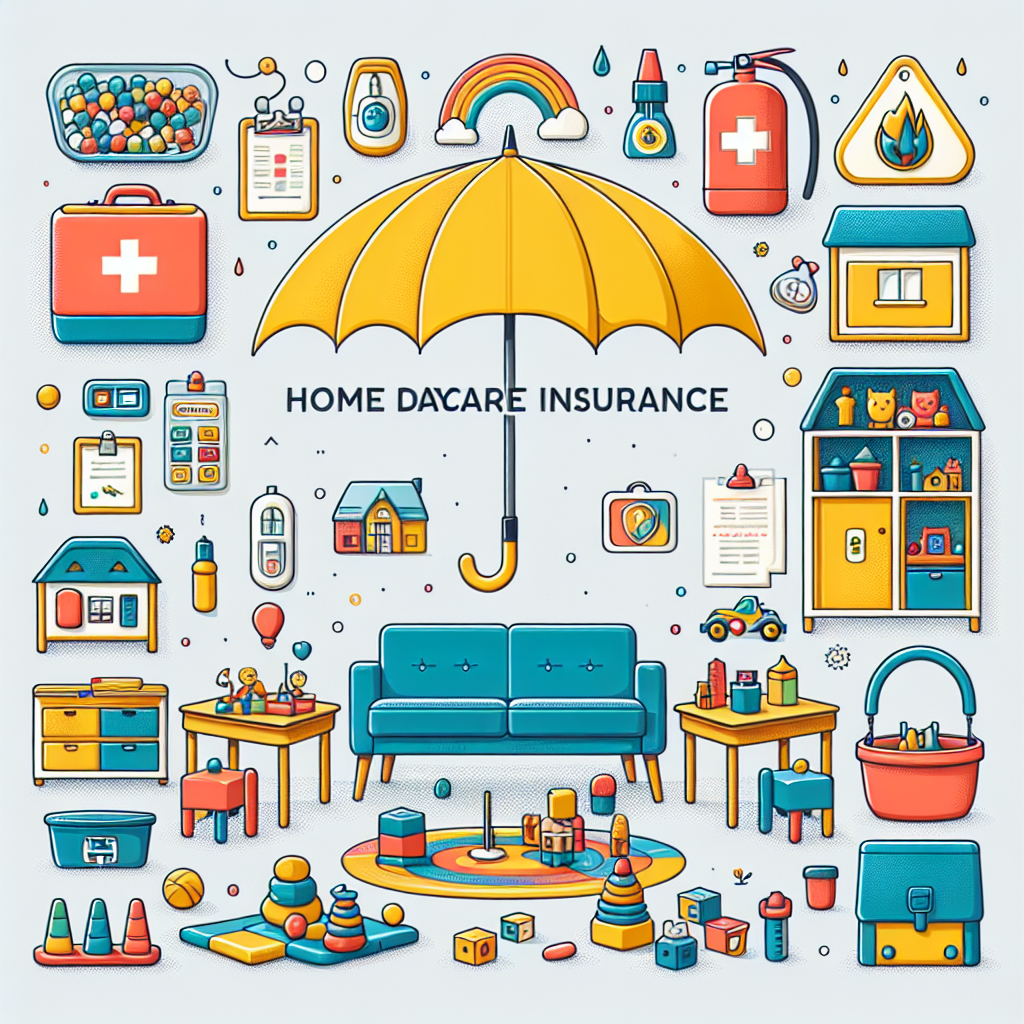Filed under Home Insurance on
Home Daycare Insurance Coverage: What You Need to Know

Why Insurance Matters for Home-Based Child Care
Running a family child care business from your home is rewarding and community-driven, but it also carries significant responsibility. Parents trust you with their children, regulators expect you to meet standards, and your own household assets are on the line if something goes wrong. That is why home daycare insurance coverage is not just a nice-to-have; it is a foundational business tool that protects your livelihood, the families you serve, and your peace of mind.
Contrary to common assumptions, a standard homeowners policy is designed for personal risks, not the unique exposures created by supervising multiple children, collecting fees, maintaining play areas, and transporting kids. Investing in home daycare insurance coverage closes those gaps with protections tailored to your daily operations.
What Does Home Daycare Insurance Coverage Include?
Every program looks different based on the number of children, the activities you offer, and whether you employ assistants. A well-rounded policy aligns with those realities. The following components are commonly bundled or available as add-ons through specialty insurers and brokers focused on family child care.
General Liability
This is the backbone of most policies. It helps pay for bodily injury or property damage claims arising from your operations, such as a slip on a wet floor or a broken window at a park during an outing. Look for coverage that includes premises and operations liability as well as products and completed operations for activities like crafts or food service.
Professional Liability (Errors and Omissions)
Professional liability addresses claims alleging negligence in your caregiving duties—think supervision, safety protocols, or developmental guidance. While the line between “general” and “professional” can blur, many insurers provide an endorsement or separate insuring agreement to make sure you are protected for decisions tied to your expertise.
Abuse and Molestation Coverage
This sensitive but essential coverage responds to allegations of physical or sexual abuse. Many family child care policies exclude or limit this risk unless you add a specific endorsement and follow strict risk controls like background checks and training. Work with your agent to understand sublimits, defense cost treatment, and whether coverage is on an occurrence or claims-made basis.
Corporal Punishment Liability
Some insurers offer an endorsement for allegations related to discipline practices. Even providers who never use physical discipline can be accused by a child or parent; having clarity on what is covered and what is not is critical.
Accident Medical Payments
Often called “accident medical,” this no-fault coverage helps pay for a child’s medical costs after an injury regardless of liability. It can defuse conflict with parents and reduce the likelihood of a larger liability claim. Limits typically range from a few thousand dollars to tens of thousands.
Business Personal Property (BPP) and Equipment
Your toys, learning materials, nap mats, tablets, and playground equipment are business property. BPP coverage insures them on- or off-premises against perils like theft, fire, or vandalism. Make sure your inventory and valuation method are up to date—replacement cost is usually worth the extra premium.
Business Income and Extra Expense
If a covered loss like a kitchen fire forces you to suspend operations, business income coverage helps replace lost revenue during the downtime. Extra expense helps pay for temporary space or accelerated repairs so you can reopen sooner.
Commercial Auto or Hired/Non-Owned Auto
If you transport children—even occasionally—your personal auto policy may exclude business use. Commercial auto or a hired/non-owned auto endorsement can protect you if there is an accident while transporting kids or running business errands.
Workers’ Compensation
If you have assistants or employees, most states require workers’ comp to cover job-related injuries and illnesses. Family members who assist may be treated differently depending on your state’s rules—ask your agent for guidance.
Umbrella Liability
An umbrella policy extends your liability limits beyond your primary policies, often in $1 million increments. Given the potential severity of child injury claims, many providers opt for an additional $1–$3 million in umbrella protection.
Cyber and Data Liability
From online parent portals to digital payment systems, even small providers handle sensitive information. Cyber coverage helps with data breaches, cyber extortion, and regulatory notification costs.
Homeowners Insurance vs. Business Coverage: The Reality Check
The Insurance Information Institute and major carriers consistently caution that homeowners policies generally exclude business-related liability. A child’s injury while you are acting as a paid caregiver may not be covered, and personal property limits seldom reflect the value of your business contents. Some insurers offer a small, home-business endorsement, but those endorsements often have low limits and exclude key perils specific to child care. For genuine protection, you need a policy designed for family child care risks.
Licensing, Legal Requirements, and Compliance
Regulations vary widely by state and municipality:
- Some states require proof of liability insurance to obtain or renew a license.
- Others require written disclosure to parents if you do not carry insurance and may mandate informed consent forms.
- Background checks, CPR/first aid certifications, safety plans, and child-to-staff ratios are standard licensing pillars that insurers also consider in underwriting.
Because insurance and licensing go hand in hand, verify the latest requirements with your state’s child care licensing agency and consult a knowledgeable local broker. Document compliance; insurers may require evidence such as training certificates, inspection reports, and signed parent handbooks as part of underwriting or claims handling.
How Much Insurance Do You Need?
The right limit depends on your operations, contracts, and personal risk tolerance. Start with your licensing standards and any agreements with schools or referral networks that specify minimums. Many providers carry $1 million per occurrence and $2 million aggregate for general liability, plus abuse and molestation coverage with a dedicated sublimit. If you own a home and have savings or rental properties, consider an umbrella to protect those assets.
A seasoned agent can model different claim scenarios—such as playground injuries or allegations of negligent supervision—to show how limits would respond. Remember that legal defense costs can consume a large portion of a limit if not paid outside the limit. Ask your insurer how defense is handled.
What Affects the Cost of Home Daycare Insurance Coverage?
The cost of home daycare insurance coverage typically reflects your risk profile. Expect pricing to vary based on the following:
- Number and ages of children enrolled, including infants
- Hours of operation and days per week
- Services offered (transportation, field trips, swimming, cooking activities)
- Safety measures (fencing, soft surfaces, locked storage, emergency plans)
- Claims history and prior insurance
- Training and credentials (CPR, early childhood education, specialized certifications)
- Location, building construction, and proximity to emergency services
- Selected limits, deductibles, and optional endorsements
Specialty carriers that focus on child care often offer more competitive terms and broader coverage than generic home-business endorsements. An independent agent can shop multiple programs to find a balance between premium and protection.
Common Claim Scenarios—and How Coverage Responds
Understanding real-world risks helps you tailor your policy:
- Playground injuries: A child falls off a climber and fractures an arm. General liability addresses allegations of negligence; accident medical may help with immediate medical bills.
- Food-related incidents: An allergic reaction or choking event triggers emergency care. Professional liability can respond to alleged failures in supervision or allergy management.
- Property damage: A kitchen fire damages your home and business contents. Property coverage (through a business endorsement or commercial package) repairs structural damage and replaces equipment; business income covers lost revenue while closed.
- Abuse allegations: A claim is made against you or an assistant. Abuse and molestation coverage, if endorsed, may provide defense and, when warranted, indemnity subject to policy terms and conditions.
- Transportation accidents: A fender bender while transporting children leads to injuries. Commercial auto or hired/non-owned auto responds, not your personal policy.
Occurrence vs. Claims-Made: Why It Matters
Two liability forms dominate the market:
- Occurrence: Covers claims resulting from incidents that happen during the policy period, regardless of when the claim is filed.
- Claims-made: Covers claims made during the policy period for incidents that occur on or after the policy’s retroactive date. Tail coverage may be needed when you cancel or switch carriers.
Ask which form applies to general liability, professional liability, and abuse and molestation. Many providers prefer occurrence due to long-tail allegations, but availability and price can vary.
Key Exclusions to Watch For
No policy covers everything. Read your forms carefully and clarify the following with your agent:
- Animals or certain breeds if you have a pet on premises
- Trampolines, pools, and water features
- Transporting children without a specific endorsement
- Contractual liability, especially broad hold harmless clauses
- Communicable diseases and pandemic-related claims
- Lead, mold, or asbestos exposures
- Intentional acts and corporal punishment unless specifically endorsed
- Professional services unless covered under a professional liability endorsement
If you identify an exclusion that conflicts with your program, see if an endorsement or risk control measure can address it. Some carriers will consider exceptions when you implement safety protocols and training.
Risk Management That Strengthens Your Insurance
Insurers reward providers who proactively reduce risk. A thoughtful safety culture also reassures parents and supports your reputation.
Practical Steps
- Screening: Conduct comprehensive background checks and reference verifications for all staff and frequent volunteers.
- Training: Maintain current CPR/first aid certifications and log regular drills for fire, weather, and lockdown scenarios.
- Supervision ratios: Adhere to or exceed state ratios; adjust during higher-risk activities like outdoor play.
- Facility safety: Use gates, outlet covers, locked storage for cleaners/medications, and age-appropriate equipment on soft surfaces.
- Allergy management: Keep updated allergy/action plans for each child; train staff on EpiPen use and safe food handling.
- Documentation: Incident reports, daily attendance, medication logs, and parental consent forms create a defensible paper trail.
- Transportation protocols: Car seats appropriate for age and size, written permission, and driver MVR checks.
- Communication: A clear parent handbook with policies on illness, discipline, payments, and emergencies reduces misunderstandings.
Organizations such as the National Association for Family Child Care, state licensing agencies, and the U.S. Consumer Product Safety Commission publish best-practice guidance you can incorporate into your policies and procedures.
Working With Parents: Contracts and Certificates
Clear expectations prevent disputes later. Include insurance language in your parent agreement that explains your coverage, what it does not cover, and how incidents are handled. Many providers also supply a certificate of insurance upon request. If you partner with schools or host events, those organizations may ask to be added as an additional insured; your agent can issue endorsements and certificates to meet those requirements.
How to Shop Smart for Home Daycare Insurance
- Clarify your operations: Ages served, capacity, hours, staffing, transportation, special activities, pets, and any water features.
- Prepare documents: License, training certificates, safety checklists, parent handbook, and prior loss runs if you have past insurance.
- Work with a specialist: Independent agents and brokers who regularly place child care accounts know which carriers provide strong terms.
- Compare coverage, not just price: Look at liability limits, deductibles, abuse/molestation terms, defense cost handling, and sublimits.
- Align with your budget and risk tolerance: Consider an umbrella and accidental medical coverage to cushion severe events.
- Review annually: Update your agent on growth, new equipment, or program changes that alter your risk profile.
As you compare options, ask each insurer to describe how their home daycare insurance coverage handles communicable disease exclusions, claims handling timelines, and access to risk management resources.
A Quick Case Study
Tanya runs a licensed family child care for six children, ages 1–5. She invested in general liability ($1 million/$2 million), professional liability, abuse and molestation ($250,000 sublimit), accident medical ($10,000), BPP ($25,000 replacement cost), and a $1 million umbrella. When a toddler tripped over a play tunnel and required stitches, Tanya filed an incident report and notified her insurer the same day. The accident medical coverage quickly reimbursed the emergency visit, and the parents chose not to pursue a liability claim. A year later, a kitchen electrical malfunction caused smoke damage, and business income coverage helped Tanya replace lost revenue during cleanup. Both incidents validated her decision to carry comprehensive protection tailored to child care.
Trends Shaping Family Child Care Risk and Insurance
- Demand surge: With shifting work patterns and rising center-based tuition, family child care remains a vital option for many parents. Growth often means higher enrollment and extended hours—both influence limits and premium.
- Digital operations: Electronic billing, texting, and parent apps introduce cyber risk; insurers increasingly offer affordable, scaled-down cyber endorsements.
- Outdoor enrichment: Providers investing in nature play and outdoor classrooms should review equipment standards, surfacing, and supervision plans with their insurer.
- Health protocols: Post-pandemic expectations around illness policies, sanitation, and ventilation persist. Clarify how your home daycare insurance coverage addresses communicable disease exclusions and what risk controls are recommended.
Frequently Asked Questions
Do I need home daycare insurance coverage if I only watch a few children?
Yes. Even one paid child can convert an incident into a business exposure that a homeowners policy may not cover. Tailored coverage is vital regardless of size.
Is it expensive?
Premiums vary, but many providers find that the cost of home daycare insurance coverage is manageable compared to the financial consequences of a single claim. Specialty programs often bundle key protections at competitive rates.
Will parents be reassured by my insurance?
Absolutely. Sharing a certificate of insurance and explaining your risk controls can be a differentiator for families comparing providers.
What if I also teach lessons, sell crafts, or offer tutoring?
Tell your agent. Side activities can change your risk profile. You may need endorsements or separate coverage depending on the exposure.
What documents should I keep for claims?
Incident reports, parent communication logs, attendance records, medical authorizations, and training certificates often play a critical role in defense and coverage decisions.
A Step-by-Step Incident Response Plan
- Ensure safety: Provide first aid, call 911 if necessary, and secure the area.
- Notify parents promptly: Be factual and calm; document the conversation.
- Complete an incident report: Include time, location, witnesses, and actions taken.
- Preserve evidence: Keep equipment involved in the incident and take photos.
- Notify your insurer or agent: Early notice helps protect your rights under the policy.
- Follow up: Track medical outcomes and maintain communication with the family and insurer.
Checklist: Strengthen Your Application and Lower Risk
- Up-to-date license and inspections
- Written parent handbook and signed acknowledgments
- Documented safety rounds and maintenance logs
- Allergy and medication policies with annual updates
- Transportation permissions and car seat policies
- Background checks and training records for all staff
- Emergency contacts and reunification plan
- Inventory of business personal property with photos
Putting It All Together
At its core, home daycare insurance coverage exists to keep your mission alive—helping children learn and thrive in a safe, nurturing environment—when the unexpected happens. By pairing the right policy structure with disciplined risk management, clear parent communication, and ongoing training, you build resilience into your program and protect what you have worked so hard to create.
Before you open your doors—or enroll another child—schedule time with a knowledgeable agent who understands family child care. Bring your license, safety plans, and questions about limits, exclusions, and endorsements. Compare quotes thoughtfully, not just on price but on how each option addresses your specific operations. With the right home daycare insurance coverage, you can focus on what matters most: providing exceptional care with confidence.
In a field where trust is everything, robust insurance is more than a line item. It is a promise to families and to yourself that you are prepared, professional, and committed to doing things the right way—today and every day your doors are open.




